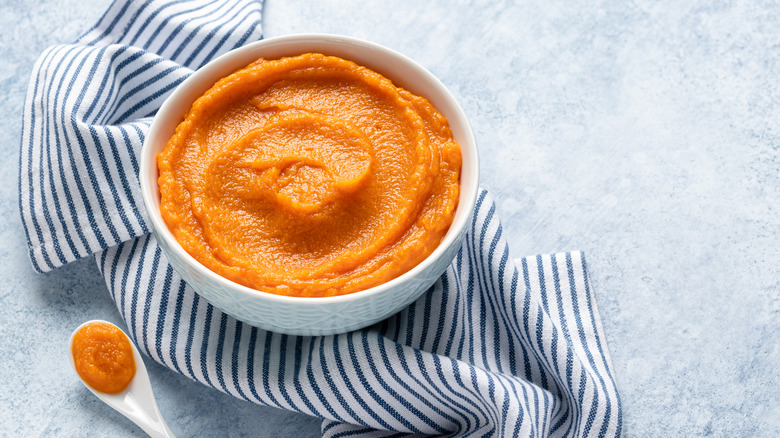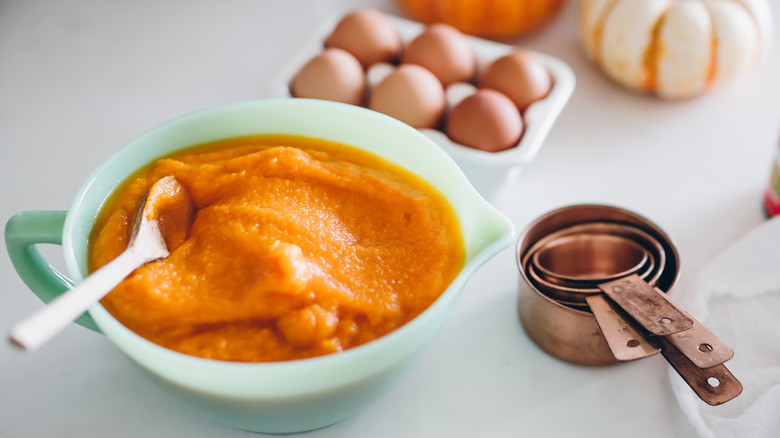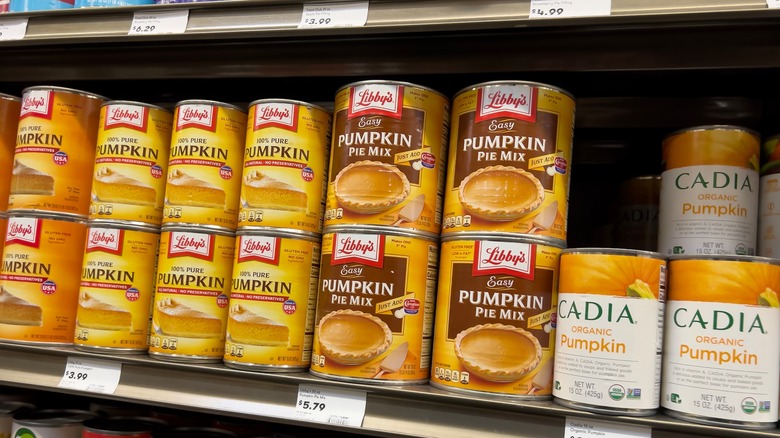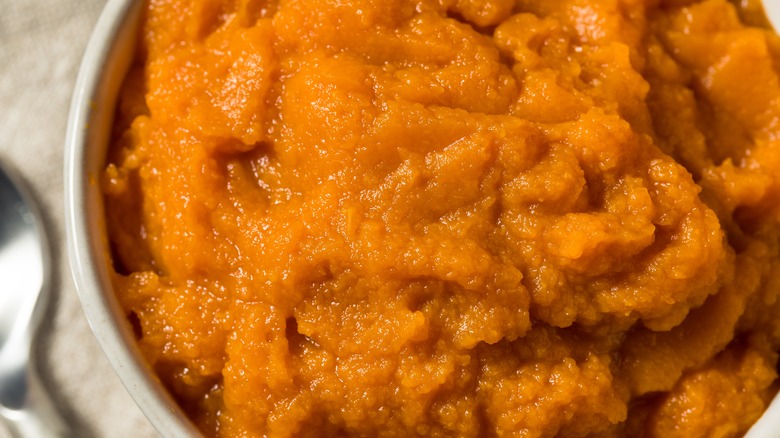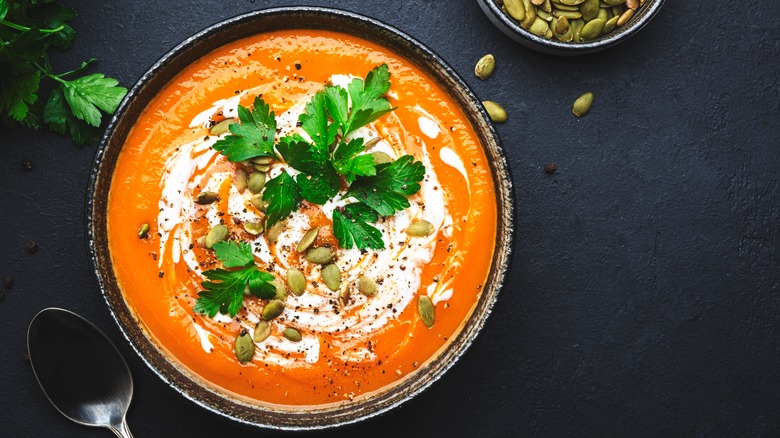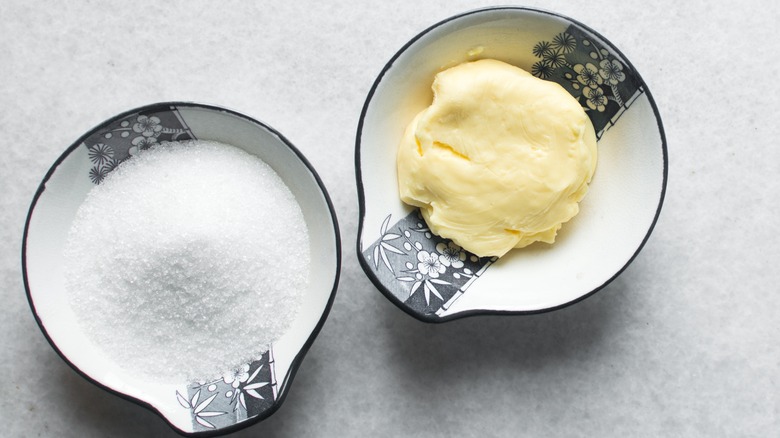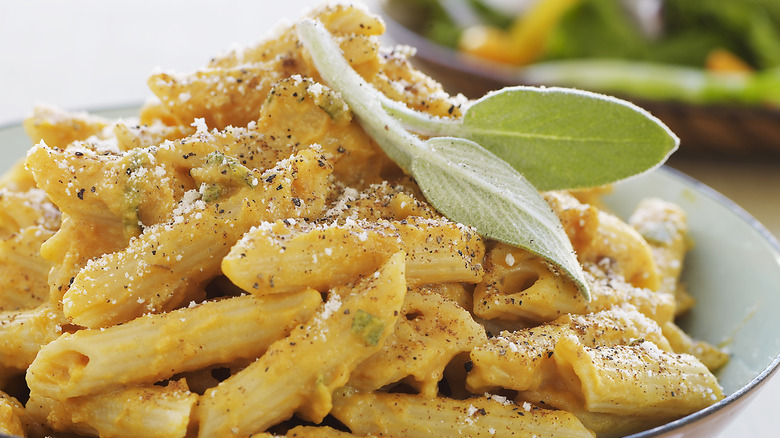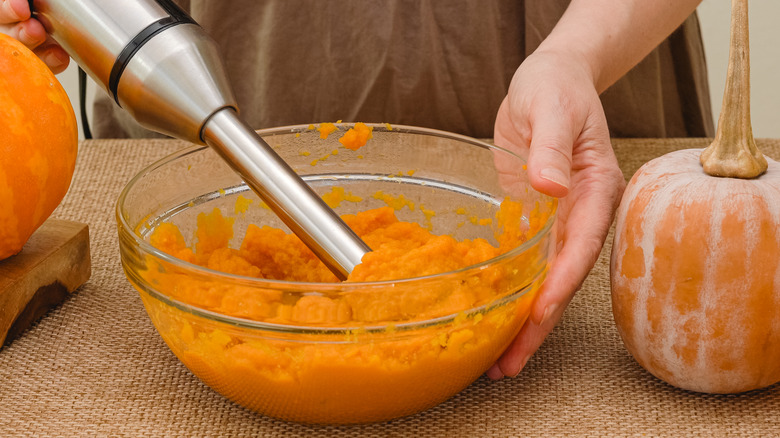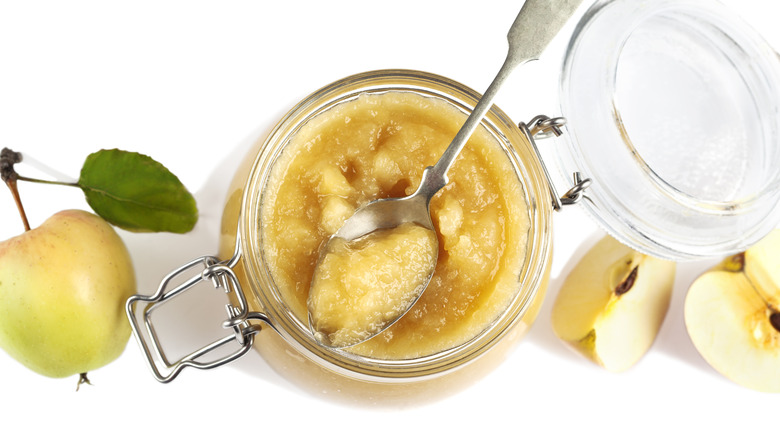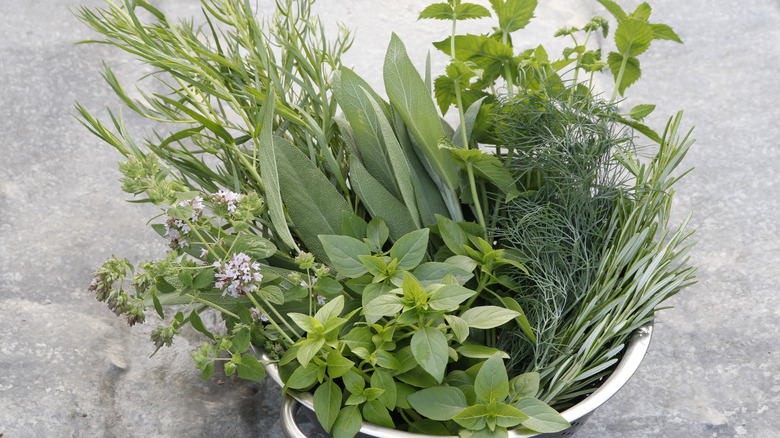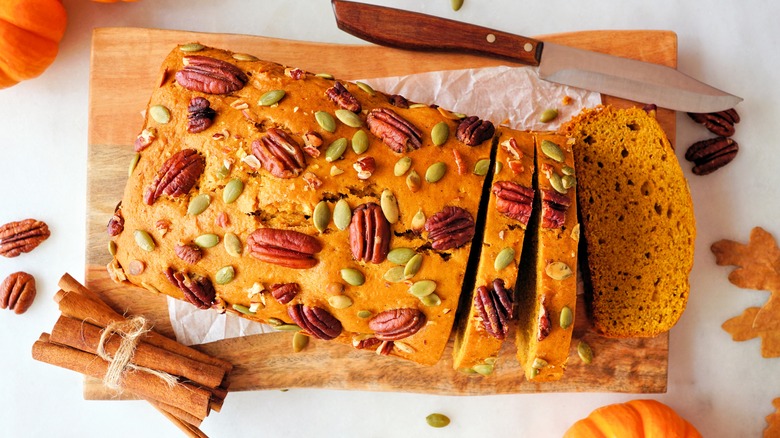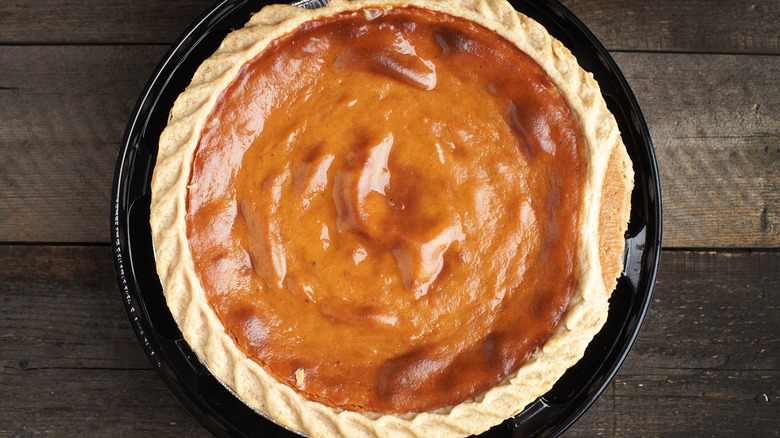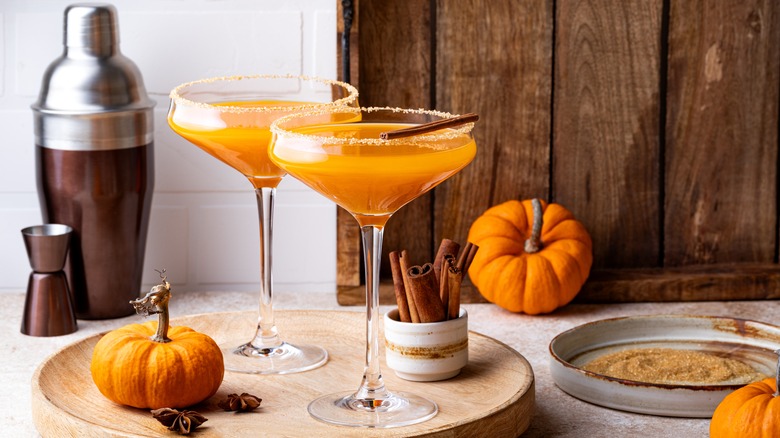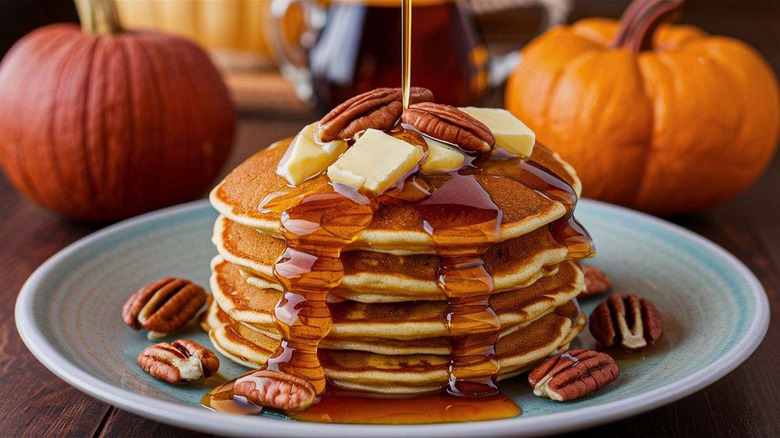13 Common Mistakes To Avoid With Canned Pumpkin
Many of us think canned pumpkin can simply be added to a recipe straight from the, uh, well, can — no questions asked. However, while canned pumpkin is undeniably more convenient than making a puree from scratch, it may be more finicky than you think. Depending on what you're making, it might even make things more difficult, especially if you're committing one of several common mistakes. Wait, what? Are there canned pumpkin mistakes? Yup, 13 to be exact. It's okay, though — you're in good hands.
To uncover the most common mistakes people are making with canned pumpkin I combed through subReddits, food blogs, and culinary sites to see what kinds of issues other people are encountering and how to fix them. I also considered my personal experience (I have quite a bit) making drinks and cooking with canned pumpkin. What you find below divulges everything I learned along the way. Hopefully, once you read through the common canned pumpkin mistakes ... you will never make any of them again.
Not using the right amount of egg with canned pumpkin
Many recipes that call for pumpkin puree also include eggs, especially when it comes to baked goods like pies and cakes. While it is often more than fine to tweak recipes a bit and stray from the official list of ingredients and their quantities, this isn't the case with eggs and canned pumpkin. The balance between eggs and pumpkin puree needs to be spot on. Otherwise, your baked goods won't turn out as expected, and no one wants all that hard work to go to waste, right?
A great example of how egg and pumpkin puree interact when baked can be seen with a true classic: Pumpkin pie. Regardless of the recipe you use, you want to follow the instructions for how many eggs to use in the filling. If you leave the egg out entirely, your pie will turn out like soup, runny, and unable to slice. Adversely, if you use more egg than a recipe calls for, your pie will likely come out much too dense, almost like a cake. While this isn't all bad, it certainly isn't ideal. You can always experiment with adjusting seasonings, just follow the recipe regarding eggs and you'll do great.
Trying to use pumpkin pie filling the same way you would pumpkin puree
Canned pumpkin pie filling and plain old canned pumpkin puree are typically shelved right next to each other in the grocery store. While this makes perfect sense, it can also cause some confusion if you aren't paying attention. If you've ever grabbed one while intending to buy the other, you know what I'm talking about. It may seem harmless to substitute one for the other, but often, that is not the case.
Pumpkin pie filling and pumpkin puree vary in terms of the amount of sugar added. They also contain different amounts of spice. As a result, they taste and work with recipes differently. If you try to use pumpkin pie filling to make a savory dish, it will likely miss the mark because of how sweet it is. Even if you are making a sweet recipe, it could still turn out too sweet because the recipe won't account for the extra sugar in the filling. Sure, you could adjust the recipe's sugar and spice quantities, but it's best to not even try. Stick to pumpkin puree, unless you are making a pie.
Using pumpkin puree that is too wet
Typically, extremely wet and juicy pumpkin puree is made from scratch, at home. However, often you come across a can that is a bit too wet for many recipes, particularly baked goods. When this happens, removing some of the excess liquid is a smart move.
According to a pro tip on Reddit, "Whether you're making pumpkin cheesecake, pie or muffins, the trick to silky, light and flavorful pumpkin desserts is to remove the excess moisture from the canned puree." The commenter recommends removing moisture by placing a stack of four paper towels on the counter and spreading your canned pumpkin in a fine layer over the top. Then, press another stack of paper towels on top and watch as it sucks up moisture. When you're satisfied with the results, simply roll the puree off of the paper towels and proceed like normal.
If the above method sounds a bit messy for your liking, you have a couple options. First, you can put your canned pumpkin in a sieve and place it over a bowl in the fridge for a few hours, maybe even overnight. This will help transform wet pumpkin puree into a thicker form perfect for baking. Your second option — which is great if you don't have time to let it sit for hours — is reducing it on the stove. Simmering on low heat helps excess moisture evaporate, leaving you with a richer, less watery version ideal for baking and more.
Not balancing flavor with sweetener, acid, salt, or spices
Achieving the ideal balance of salt, acid, heat, and sweetness is a true game-changer when it comes to creating cohesive dishes full of flavor. Staying true to this principle, it would be a mistake to forget about balancing the flavor of canned pumpkin with the same elements. Not all at once. How you achieve the ideal flavor profile will vary depending on what you are making, but you get the idea.
For savory pumpkin dishes, adding a dash of acidity goes a long way. Just a small amount of vinegar, lemon juice, or maybe even tomatoes lifts and brightens the taste of canned pumpkin. Adding warming spices like cloves, cinnamon, and nutmeg, help enhance and deepen flavor as well. Cumin, cayenne pepper, and chili powder also pair perfectly with pumpkin. Of course, you can't forget salt either — salt makes everything taste better.
On the other end of the spectrum, adding a bit of something sweet, like sugar, maple syrup, or honey helps sweet recipes achieve their true glory. Just remember, canned pumpkin is already a little sweet, so start by adding your sweetener of choice slowly and taste as you go.
Attempting to use canned pumpkin as a straightforward substitute for butter and sugar
It's true, pumpkin puree can actually be used as a substitute for butter and sugar in some recipes. However, it shouldn't be used as a blanket substitution for the ingredients. After all, baking is a science. Adjusting liquids and ingredients always affects the final outcome, and not necessarily in a good way.
When attempting to make a successful butter for pumpkin puree swap, you'll want to adjust the measurements. A 1:1 ratio is not recommended. Instead, use ¾ cup of pumpkin puree for every one cup of butter. Or, better yet, use both. Only swap out half of the butter for canned pumpkin and you'll get a deliciously rich outcome.
In addition, canned pumpkin is inherently sweet, so you can reduce sugar in recipes where you use it as a substitute for butter. However, because pumpkin isn't nearly as sweet as sugar, you'll probably still want to include some sugar to achieve the ideal taste, just less than the original recipe calls for.
Only using canned pumpkin in sweet recipes
Canned pumpkin and sweet recipes are a no-brainer, but forgetting how amazing the flavorful puree is in savory recipes is a big mistake. I'm not saying you should abandon your sweet pumpkin favorites like pie, ice cream, and muffins, but you definitely should not limit yourself to them. As it turns out, canned pumpkin is also a game-changer in a myriad of savory recipes. Its complex, fall-inspired flavors bring lots of dishes to new heights.
Canned pumpkin is a welcome addition to many soups, stews, and chilis. For example, doesn't a pumpkin and turkey chili sound amazing? In addition, it makes a mean dip or filling for ravioli and other types of stuffed pasta. Speaking of pasta, you can also mix canned pumpkin into the dough to infuse it with rich flavor throughout. Or, use it to make a drool-worthy sauce for pasta or meat. Even Giada De Laurentiis uses canned pumpkin puree to make a comforting carbonara. So, whatever you do, don't forget canned pumpkin can be used for a whole world of recipes that aren't sweet. Get creative and infuse your favorite savory dishes with the yummy, complex flavors of canned pumpkin whenever the mood strikes.
Overmixing or blending your canned pumpkin
One of the best things about canned pumpkin is that it comes out of the tin pureed and ready to mix into countless recipes. The texture is just right, even if some brands are a bit wet (that's easily fixed), and it's beautifully smooth straight from the can. Don't mess up its simple perfection by overmixing or blending it more than necessary. Sure, you'll likely have to mix it a fair amount for many recipes, like cakes, breads, and more, but don't go overboard.
If you accidentally mix or blend canned pumpkin too much, you can expect the velvety texture to break down and become slushy or watery — two things that are less than ideal. In addition, the more you mix pumpkin puree the more air that enters, something that also changes consistency. Plus, additional air can speed up oxidation, which, in turn, gives your pumpkin a less fresh look and feel. To avoid all of these potential mishaps, only mix or blend canned pumpkin for a short period; it should maintain its perfectly smooth texture.
Forgetting it makes a great substitute for mashed bananas and applesauce
Pumpkin puree is also a fantastic substitute for mashed bananas and applesauce. All three are basically a puree, or at least pretty close to it, and thanks to pumpkin's inherent sweetness, it can be used in many of the same recipes. Swapping out either applesauce or mashed bananas for pumpkin doesn't take any tricky calculations either. You can simply use a 1:1 ratio for both.
If you are looking to spice up an old recipe or simply don't have applesauce or bananas on hand, canned pumpkin is ready to fill in the gaps. For example, it would be a perfect substitute for applesauce in sugar-dusted apple cider donuts. You still get a little apple flavor from the cider but the addition of pumpkin infuses a bold fall-inspired taste. With mashed banana, canned pumpkin works as a substitute in recipes like banana bread, cinnamon banana bread muffins, and more. If you are struggling to use leftover canned pumpkin, forgetting it is wonderful in recipes calling for mashed bananas or applesauce would be a regrettable mistake.
Overpowering canned pumpkin with bold flavors like mint, basil, dill, or tarragon
Canned pumpkin's flavor is both earthy and slightly sweet, so it pairs wonderfully with an array of spices. However, trying to force flavor combinations or overpowering the subtle yet vibrant taste of pumpkin is a big mistake — and with some herbs and spices, it's easier done than with others. Bold seasonings like mint, basil, dill, and tarragon are the main culprits, so if you incorporate them into a recipe, make sure to use sparingly. While I would stay far away from most of them, basil is where I make an exception. I still only add small amounts, but a touch of fresh basil paired with a pumpkin pasta sauce can be quite delicious. Just make sure you don't use too much or your pumpkin will fade into the background.
This warning doesn't mean you should steer clear of all seasonings. There are quite a few that amplify and complement canned pumpkin to perfection. Of course, there are the obvious ones, like cinnamon, clove, and nutmeg. But Latin flavors like cumin, coriander, and cayenne pepper also taste amazing in pumpkin. Savory seasonings like rosemary, sage, and thyme are friends with canned pumpkin as well. Whatever seasonings you choose, make sure to start slowly, taste as you go, and you won't make any silly mistakes that can't be undone.
Underbaking pumpkin puree
As we know, canned pumpkin is pretty wet, especially if you don't extract some of the excess moisture before incorporating it into your recipes. While this isn't always an issue, it can affect how it bakes and you want it to bake thoroughly. If not, your tasty goodies will be gooey and undercooked in the center. Undercooked pumpkin is a big no-no when it comes to texture. It is delectable when cooked properly, but a hot mess when it's not.
Unfortunately, it isn't always easy to tell if pumpkin puree is properly baked because of its high moisture content. Simply touching a loaf of pumpkin bread, cake, or muffins to get a feel for its "doneness" won't provide the same level of accuracy as it would with other baked goods. While your bread may feel right to the touch, it could still be somewhat underdone in the center. To ensure you always pull your dishes out of the oven at the right time, it may be best to eliminate the guesswork and use a probe thermometer. As long as your breads and muffins reach 200 F in the center you should be all set. For pies, 175 F should suffice.
Baking or heating canned pumpkin for too long
As you probably know, canned pumpkin is already cooked. In fact, that's one of the reasons we like using it so much; it's undeniably convenient. However, it also means it is somewhat easier to overheat or bake than you might think. Really, all it needs is to be heated up. When adding it to soups, pasta sauces, and other foods, it doesn't need to be incorporated right at the beginning. Actually, mixing it in near the end is typically your best bet. That way, overheating shouldn't be an issue.
Overbaking canned pumpkin can cause the sugar in the puree to caramelize, unfortunately not in a positive way either. When the sugars caramelize too much, it can make your baked goods taste overbearingly sweet, slightly burnt, or at the very least, off. In addition, it can be tricky to tell when baked goods with pumpkin puree are done. The extra moisture could make your baked goods still feel a bit moist when they are actually ready to come out of the oven. As someone who has made this mistake several times, I should know. With both of these overbaking precautions in mind, I find it is best to use a timer and maybe even check progress a couple of minutes before just in case your creation is baking faster than expected.
Forgetting canned pumpkin is tasty in drinks
Drinks are another place canned pumpkin shines, and forgetting this is most certainly a mistake. Thanks to its pureed form, canned pumpkin easily mixes into a world of different drinks. You don't need much, so it's very simple to pull off and a fantastic way to take advantage of even the tiniest amount of unused puree in your can. That is, of course, if you can limit yourself to just one drink.
From frosty cocktails and martinis to warm coffees and teas to delicious fall-inspired non-alcoholic creations, canned pumpkin has limitless potential when it comes to mixing up tasty beverages. Making a pumpkin hot chocolate, latte, or coffee (hot or iced) is as simple as stirring in a small spoonful of puree and enjoying. It also makes a deliciously creamy pumpkin smoothie and again, all you have to do is add a spoonful to your other smoothie ingredients and mix — or blend in this case. My favorite pumpkin smoothie is made with coconut water, vanilla yogurt, spinach, peanut butter, banana, and canned pumpkin blended with ice. Or, for a more adult-themed drink, try making a pumpkin espresso martini. It's probably easier than you think and it is sure to be a crowd-pleaser at any Fall gathering.
Not using it all before it goes bad
Considering how many recipes can be made with canned pumpkin, letting any go to waste is disappointing. As we now know, it tastes phenomenal in countless drinks and endless savory dishes. Plus, it is a winning flavor in a limitless number of sweet recipes as well. Anything from cottage cheese pumpkin cheesecake to pancakes to pumpkin waffles to pumpkin bread pudding is ready to help you put your leftovers to good use. It also tastes fantastic swirled into yogurt or oatmeal. Or, for any vegans, pumpkin pecan rice pudding is a delight. It's also delicious if you're not a vegan.
Even with all the recipe options, you may still find yourself with more of this versatile canned good than you can use before it needs to be tossed. When this happens, you can always freeze canned pumpkin, either in a bag or into cubes, and save it for future use. That will buy you anywhere from four months to a whole year to enjoy it. Dogs also love pumpkin, and according to the American Kennel Club, it's good for their digestion too. So really, you don't have any excuses not to use every last drop of your leftover canned pumpkin while it is still good.

